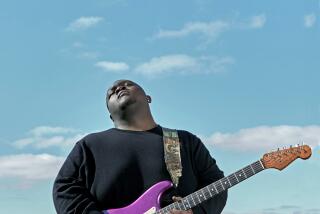Barney Kessel, 80; Jazz Guitarist Was a Lyrical and Melodic Innovator
- Share via
Barney Kessel, the innovative and influential jazz guitarist known for his lyrical voice and harmonic improvisation, has died. He was 80.
A pioneer of the electric guitar, Kessel died Thursday night in San Diego, where he had lived since 1989. The cause of death was a malignant brain tumor. He had been in poor health since 1992, when he had a stroke that curtailed his nearly six-decade musical career.
“Barney was a wonderfully lyrical and melodic player and could also swing very hard,” jazz critic Nat Hentoff told The Times on Friday. “He was a guy who could sit in and play with everybody. He had what jazz players call ‘big ears,’ meaning he had a great capacity to listen and to respond musically to what he was hearing.”
Between 1947 and 1960, Kessel was rated the No. 1 guitarist in many of the music polls in Esquire, Down Beat and Playboy magazines.
In the 1950s, he recorded several albums and performed with drummer Shelly Manne and bassist Ray Brown in a groundbreaking piano-less trio.Kessel also appeared and recorded with Charlie Byrd and Herb Ellis as the “Great Guitars.”
A Times reviewer catching a 1982 concert by Kessel and Byrd -- Ellis had the flu -- wrote that it was “such a near-perfect performance of melodic, swinging jazz that a more appropriate appellation might be the ‘Heavenly Guitars.’ ”
Kessel left jazz for many years for more lucrative work as a studio musician but returned to the road full time in 1972, saying, “I wanted to be able to take my guitar out of the case and always be me, not a guy doing a dog food commercial.”
The broad, precise demands of film, television and the recording studio, however, only enhanced his self-taught technique modeled on the work of fellow Oklahoman Charlie Christian.
Kessel played not only with the Oscar Peterson Trio (in a 1952 tour of 14 countries), Charlie Parker, Charlie Barnet, Art Tatum and Artie Shaw, but also with such diverse musicians as Elvis Presley, the Beach Boys and Liberace. He was musical director of Bob Crosby’s television variety show; signed, wrote songs for and produced records for Ricky Nelson as a Verve executive; and played on the soundtracks of such motion pictures as “Cool Hand Luke.”
Over the years, as either a leader or sideman, Kessel recorded more than 50 albums, primarily with the Verve or Contemporary labels, ranging from “Barney Kessel Vols. I and II” in the early 1950s through “Red Hot and Blues” and “Kessel Plays Standards” in the late 1980s.
Among the first guitarists to go electric, Kessel told The Times in 1990 that he also was the first to record without a piano -- truly propelling the guitar from background rhythm duties into the limelight.
As arranger and guitarist on Julie London’s 1955 album “Cry Me a River,” Kessel said, “We used guitar and bass only, and it was the first time anyone had played guitar accompaniment for a vocalist to sound like an orchestra.”
Among his other innovations, Kessel related, were using an oboe in jazz and writing a jazz version of the opera “Carmen,” which he recorded with Andre Previn on piano.
The late jazz critic Leonard Feather, who reviewed Kessel’s local performances from 1966 until shortly before Kessel’s 1992 stroke, praised the guitarist as “a bright beam in the local plectrum spectrum.”
In 1966, Feather wrote: “Barney Kessel at Shelly’s Manne-Hole just has to evoke a rave review. His guitar sounds combine lyricism and dexterity with a romping, cooking, jumping, exciting happiness.”
Critics across the country and throughout Europe echoed the opinion, with a New York Times reviewer in 1991 calling Kessel “a master in [whose] hands a good part of American music and culture become audible.” German jazz critic Joachim Ernst Berendt once said Kessel was “the most rhythmically vital guitarist in modern jazz.”
Kessel, who didn’t sing, nevertheless believed in vocal communication with his audience. So he talked between songs, using his folksy, dry Oklahoma wit to delight listeners. He encouraged them to applaud even if they disliked the music, for example, advising, “It will improve the efficacy of your circulatory system.”
Born Oct. 17, 1923, in Muskogee, Okla., Kessel began working professionally in Ellis Ezell’s band as a teenager -- a standout in 1937 not only because of his youth but also because he was the only white musician in an all-black band playing black clubs throughout Oklahoma.
Within a year he had his first electric guitar -- the only person, he once said, with the newfangled amplified instrument within a radius of 400 miles.
Kessel moved to Los Angeles, where he first became widely known playing with the Chico Marx Orchestra in 1943 and then Barnet’s and Shaw’s bands.
Jazz impresario Norman Granz liked what he heard and cast Kessel in the innovative “Jammin’ the Blues,” a classic 1944 short feature that was nominated for an Academy Award. A music video before the genre existed, the artistic black-and-white film required Kessel, as the only white musician in the all-black cast, to dye his hands black and perform in the shadows. Granz went on to put Kessel on recordings for several years.
Kessel, a member of the Jazz Hall of Fame and the Oklahoma Music Hall of Fame, owned Barney Kessel’s Music World in Hollywood from 1967 to 1970, employing some of the first guitar technicians and attracting John Lennon, George Harrison and Eric Clapton as customers.
In addition to writing music, Kessel wrote columns for Guitar Player magazine and instruction manuals including the 1967 “The Guitar: A Tutor.”
The guitarist is survived by his wife, Phyllis; his two sons from a previous marriage, guitarists and music producers Dan and David Kessel; three stepchildren, Christina Wand, Colette Wand Wirtschafter and Cleo Dougherty; and five grandchildren.
Services are private.
More to Read
The biggest entertainment stories
Get our big stories about Hollywood, film, television, music, arts, culture and more right in your inbox as soon as they publish.
You may occasionally receive promotional content from the Los Angeles Times.










